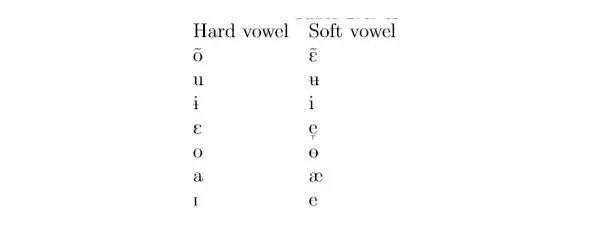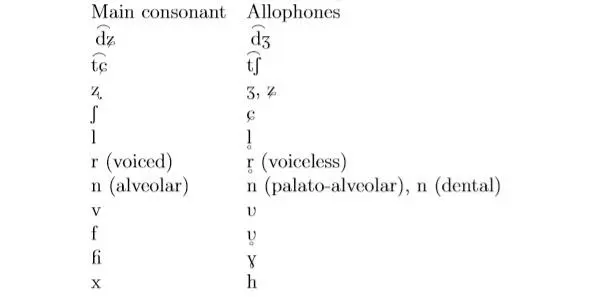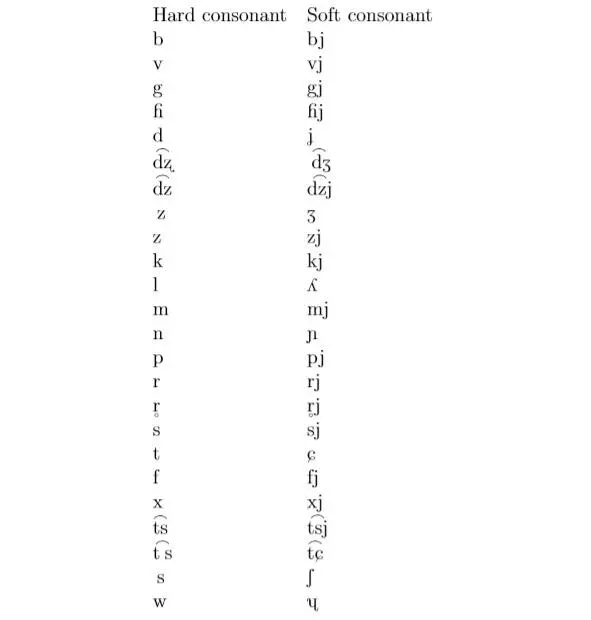If you have some knowledge about Slavic languages and their origins, you should know that the Proto-Slavic language had nasal vowels, which we can nowadays be found in Polish and Lithuanian. Do they exist in Novoslovnica? Of course they do! There are two allophones for pronouncing nasal vowels. The first one is actually a nasal vowel, when you pronounce an ordinary vowel through your nose. The second is more common, such as in French, when you add a nasal consonant [ŋ] to an ordinary vowel. Look at the sounds on the next table.
Examples:
Dųb (oak) [dõb] – [duŋb]
Męso (meet) [`mɛ̃so] – [`meŋso]
As you can see, Novoslovnica distinguishes between nasal vowels in two categories – O-nasality (hard) and E-nasality (soft).
The last topic that we will speak of pertaining to vowels, is the firmness and the softness of the vowels. Scientists argue about what is primary in making sound soft or hard – consonants or vowels. Novoslovnica claim vowels are softer or hard primarily, although consonants itself also can be either soft or hard.
There are vowels that tend to make their surrounding soft and there are vowels that tend to make their surrounding hard. As you already know, there are two nasal vowels – one hard (O-nasality) and one soft (E-nasality). However, there are other pairs of hard / soft vowels among ordinary ones. Look at table 1.4 for more information.

Hard and soft vowels
Examples:
Dodatek (addition) [do`datek]
Smërtj (death) [sme̞rc]
There is only one vowel that has no pair in softness / hardness. It is ə. This vowel is named the «schwa» sound and it can be described as the most «middle» sound among vowels. To pronounce it you should relax your oral cavity and pronounce a sound with weakened muscles. This is the «schwa» sound.
In this paragraph about consonants, I would like to begin with the definition of a consonant.
Consonant (C) – a sound that is articulated with complete or particular closure of the vocal tract.
Likewise vowels, consonants have three characteristics that determine their position in your articulation. These three parameters are:
• Place, where the consonant is pronounced in the mouth
• Manner, how the consonant is pronounced
• Sonority, whether you use your vocal cords or not
Place of the consonant can be quite different. Here are possible types: Bilabial, labiodental, dental, alveolar, postalveolar, palato-alveolar, retroflex, alveolo-palatal, palatal, labio-velar, velar . There are more types, but they do not exist in Novoslovnica.
Manner is the way how you pronounce the sound. There are also different manners, that are used in Novoslovnica. They are: nasal, stop, affricate (sibilant), sibilant fricative, non-sibilant fricative, approximant, trill, lateral approximant .
Sonority is the boolean attribute of pronunciation. You can either use your voice with the sound you pronounce or not . Notice that vowels cannot be pronounced without the use of your voice.
Combining these three parameters, we get the unique consonant that we want to pronounce. We cannot draw a 3-dimensional table, because there are three parameters on input, so we will combine information into 2-dimensional space as in paragraph about vowels. So, look at the figure and see the different consonants that are used in Novoslovnica.

Consonant sounds in Novoslovnica
Different colors of the cells show the sonority of the consonant. Yellow color shows that the sound is voiced, while green ones are for voiceless sounds.
Blue cells in the table show that sounds in it can be used both in voiced and voiceless forms as allophones.
Novoslovnica has 51 consonants, 21 of them are voiceless and 30 are voiced.
However, not all of these consonants are language phonemes. So, let’s talk about the allophones among these sounds.

Consonant allophones in Novoslovnica
Exception: The sound θ has no pair, because its pair ð has never been used in Slavic languages.
Likewise vowels, consonants can be compared with each other in terms of softness / hardness. The common rule is that every consonant has its soft or hard partner.
Exception: Two sounds are exceptions to this rule.
• Also nasal velar consonant ŋhas no soft pair.
• And vice versa, the sound jis soft and has no hard pair.
Remember this exception, let’s look at the table 1.7 to get acquainted with pairs of consonants.

Hard and soft consonant allophones
As you see, every consonant from table has its own soft pair. The soft consonant is usually written as a hard consonant with the sound jattached, but some of them are provided as unique sounds by IPA, because in some languages they can be phonemes. 8 8 There were some attempts to use IPA for creating a language alphabet. Thus, history of IPA itself dates back to the Romic alphabet in 1887 when it was suggested to use a phonetical alphabet for English. Also there were some other attempts for western language to use symbols that further became IPA units.
By reading this paragraph you should be aware about Novoslovnica phonemes. At the beginning we will speak about two main features of the language: reproduction and alternation.
Reproduction (extra sounds) – is a process of adding a new sound (consonant or vowel) in the word.
Alternation – is a process of changing some sound (consonant or vowel) or sounds to another one (s).
What are the purposes of alternation and reproduction? These terms both obtain the single aim – to make our speech comfortable for ourselves.
Every language has its own comfortable combinations of sounds and avoided ones. Some languages alternate these uncomfortable character rows into another ones that are comfortable for language speaker in writing, some languages keep writing etymological and alternate the pronunciation of the uncomfortable words. Take into account the fact, that the concept of comfort is relative, that means two different languages (which are spoken by different nations) have different modes of comfort.
Example: you can look at and compare German and Dutch languages. They are very close, but they have different ways for comfortable pronunciation. The word «book» in German sounds like «Buch», but in Holland it sounds like «boek». Thus, you see that these words are familiar, but their pronunciation differs a lot.
Moreover, even one language spoken in different areas can differ greatly in the areas it is spoken.
Example: American and British English. You know that it is still the same language, but pronunciation differs so greatly that American person can not always understand in ordinary speech (quick temp of speaking) what the British person have said.
Читать дальше
















